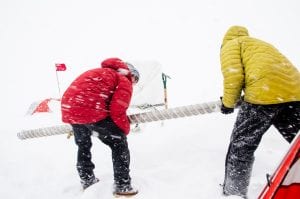Research
G&G Research Overview
The scientists, staff, and students of the Geology and Geophysics Department continue to advance our understanding of the interactions between Earth, ocean, and climate systems. Our core strengths lie in the geology and geophysics of ocean basins, and the underlying dynamics of the mantle that keep the tectonic plates in motion; the geochemistry of Earth systems, from processes deep within the Earth to interactions between geology and biology; climate change and its relation to ocean circulation; and coastal processes, including climatic effects on coastal systems and influences on their ever-changing morphology.
Areas of Interest
Coastal Processes
The study of the coastal and nearshore environment can help us answer important questions related to natural hazards, ecosystem dynamics, sediment transport, climate variability, ancient cultures, and coastal environmental issues such as groundwater management and pollution.
Related Websites
Geochemistry & Petrology
Geochemistry is an extremely powerful tool to investigate a wide variety of geosystems in the ocean basins. Department members investigate a wide range of problems including sediment biogeochemistry, submarine hydrothermal systems and the origin of mineral deposits on the seafloor, melt generation and flow in the earth’s mantle, crustal magmatic systems, and seafloor volcanic processes. Research conducted by the department staff spans the entire globe and utilizes combinations of field studies, analytical, experimental and theoretical approaches. The Department houses several state-of-the-art facilities including the National Ocean Sciences Accelerator Mass Spectrometry (NOSAMS) facility, the Northeast National Ion Microprobe Facility (NENIMF) and a Multicollector Inductively Coupled Plasma Mass Spectrometer.
Related Websites
- Seafloor Samples Laboratory - Over 14,000 marine geological samples
- The Mantle Rocks - V. LeRoux Laboratory
- The Gaetani Lab - Experimental Petrology and Geochemistry
Geomicrobiology/Microbial Ecology
Marine sediments and water columns host an incredible diversity of microbiota that exhibit complex interactions with other microorganisms and with Metazoa, and are the primary drivers of major biogeochemical cycles. By studying the ecology, physiology, genes, and physical structures of microorganisms that have evolved in or adapted to low-oxygen habitats we can gain an understanding of the capacity of and strategies for organisms to adapt to a changing climate. This knowledge is critical for predicting future impacts on marine food webs and biogeochemical cycling as well as for understanding the past. Areas of research in the Bernhard and Edgcomb laboratories include responses of microbial populations to biogeochemical gradients and climate-change related alterations including ocean acidification and deoxygenation, symbioses (especially those involving protists), microbial production and consumption of climate-active trace gases, ground-truthing of select paleo proxies, and life in the deep subsurface biosphere.
Related Websites
Geophysics & Tectonics
The G&G department has a large group studying problems in marine geophysics and tectonics including formation of the oceanic crust and lithosphere, mid-ocean ridge processes, continental rifting, oceanic subduction and upper mantle dynamics. Researchers utilize a variety of approaches in this work including sea-going observational studies (high-resolution multibeam bathymetric mapping, use of deep submergence vehicles, seismic reflection, refraction and earthquake investigations, electromagnetic sounding, magnetic and gravity studies), laboratory experimental work, and geophysical modeling. This group has close ties to the department’s geochemistry and petrology group. As of August 1st, 2018, we now run the national Ocean Bottom Seismograph Instrument Center (OBSIC) which replaces the Ocean Bottom Seismograph Instrument Pool (OBSIP).
Related Websites
- WHOI Arctic Group - interdisciplinary website of the WHOI scientists currently involved in Arctic studies
- Marine Seismology and Geoacoustics Group
- Ocean Bottom Seismograph Laboratory
- Ocean Bottom Seismograph Instrument Center (OBSIC)
Ice Sheet Dynamics / Glaciology
Ice sheets play a crucial role in modulating interactions between climate, sea level change, and ocean circulation patterns. Using highly interdisciplinary approaches that combine ice core records, laboratory studies, geophysical and remote sensing observations, and numerical modeling, members of the G&G department are working together to study how ice sheets behave under changing climatic conditions and how variations in surface melting rates influence ice sheet dynamics. Research also focuses on the development of novel proxies for studying past climate, sea ice behavior, and marine primary productivity. The department currently has active research projects focused on both the Greenland and Antarctic ice sheets.
Related Websites
- Coming Soon!
Paleoceanography & Climate Dynamics
How has Earth’s climate varied in the past, and why? How have earth surface temperature, the hydrologic cycle, and global biogeochemical cycles changed as part of this climate variability? What is the ocean’s role in natural climate change, and how are the oceans likely to respond to future changes in Earth’s climate, both natural and anthropogenic? The members of the Paleoceanography Group at WHOI use natural archives—sediment cores, corals, glacial ice—and state-of-the-art analytical tools to understand climate-linked changes in the circulation, biology, and chemistry of the oceans. They also use outputs from large numerical models to understand the complex interactions between oceans and climate.
Related Websites
Research Spotlight
Greenland Ice Sheet Melt 'Off the Charts' Compared With Past Four Centuries
A team, including WHOI Scientist Sarah Das, Joint Program student Matthew Osman, and former Post-Doctoral Scholar Luke Trusel, have shown that modern levels of Greenland ice melt and runoff are unprecedented over recent centuries, and increasing non-linearly in response to post-industrial Arctic warming.
-December 20, 2018

